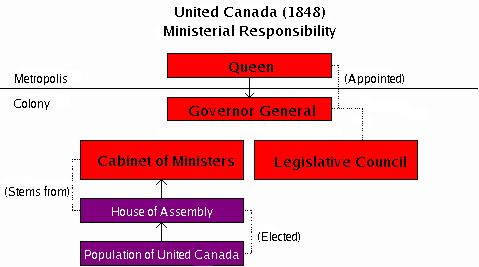Act of Union (1840)
|
|
The Act of Union passed in July 1840 and proclaimed February 10, 1841, abolished the legislatures of Lower Canada and Upper Canada and established a new political entity the Province of Canada to replace them. This act effecting the political union of the Canadas was similar in nature and in goals to the other Acts of Union enacted by the British Parliament.
History
The act was inspired by Lord Durham's report. Lord Durham was sent to the colonies to examine the causes of the Rebellions of 1837 in both Upper and Lower Canada. The union was also proposed to solve pressing financial issues in Upper Canada. Mostly through poor investments in canals that had benefited the port of Montreal, the government of Upper Canada had a budget shortfall and deeply in debt. It was hoped its finances could be salvaged by merging it with the still-solvent Lower Canada.
Gov1840.png
It was also hoped that by merging the rapidly growing anglophone Upper Canada with the slowly growing francophone Lower Canada that in time the French cultural presence in North America would disappear. Thus the act also contained measures banning the French language from official use and ending respect for French institutions such as the civil law and religious education.
The new, merged colony was named the Province of Canada, with Upper Canada renamed as Canada West and Lower Canada as Canada East. Canada West, with its 400,000 inhabitants, was represented by 42 seats in the Parliament's legislative assembly, the same number as the more-populated Canada East, with 600,000 inhabitants. The francophone majority as well as numerous anglophones considered this an injustice. In Lower Canada, Louis-Joseph Papineau demanded representation by population and the recall of the Union the minute he entered the new Parliament of United Canada.
In 1848 the Canadian colony was granted responsible government and under the Baldwin-Lafontaine government many of the more-unfair restrictions were removed.
By the late 1850s, massive immigration from the British Isles to Canada West changed the previous demographic imbalance between the English and French sections of the colony. Many politicians in Canada West began to lobby for Rep-by-Pop as they no longer considered the equal representation mandated by the Act of Union to be just.
In the end, the Act of Union failed at shutting down Francophones' political influence, especially after responsible government was granted to the colony. By voting en bloc while the Anglophones of Canada West were highly factionalized, the Francophones of Canada East guaranteed a strong, unified French Canadian presence in the legislative assembly. However, their presence remained inferior to their demographic weight in the executive and legislative councils. The government of Lafontaine-Baldwin succeeded at repealing the measure against the French language in the Parliament, in the Courts, and in the civil administration. With the double majority principle, West and East Canada were so to speak "reseparated" and for a short while, both sides were managed independently. Joint premierships shared by an Anglophone from Canada West and a Francophone from Canada East became the rule, but did not prevent continual legislative deadlock resulting from the conflicting aspirations of the two Canadas. Dissatisfaction resulting from this deadlock was the chief factor leading to Canadian Confederation in 1867.
See also
- Acts of Union of the British Empire
- Constitutional history of Canada
- History of Quebec
- Patriotes Rebellion
- Durham Report
- Quebec nationalism
- History of Canada
External links
- Full text of the act (http://solon.org/Constitutions/Canada/English/PreConfederation/ua_1840.html)
- Canadian Encyclopedia - Act of Union (http://www.thecanadianencyclopedia.com/index.cfm?PgNm=TCE&Params=A1ARTA0000029)
- Canada in the Making, 1839 - 1849: Union and Responsible Government (http://www.canadiana.org/citm/themes/constitution/constitution11_e.html)fr:Acte d'Union (1840)

